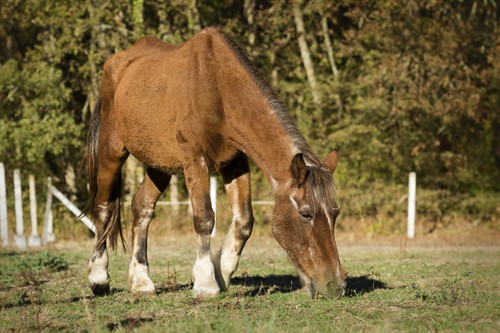
As your horse ages, he can experience dental issues. This can affect what and how they eat and could contribute to a loss of body condition. We’ll discuss signs of dental trouble and give you some suggestions for various feeding choices to help your senior horse’s health and performance.
Dental issues in senior horses
Periodontal disease often accompanies advancing age. A horse may experience tooth loss, or existing molars may become so worn that the horse can no longer chew properly. This makes it difficult to chew long-stemmed hay.
Have you noticed your horse’s body condition score decreasing, or are you finding semi-chewed hay (called “quids”) around the feeding area? Your horse is most likely struggling with dental issues and may not be consuming as much feed as you think he is. According to the American Association of Equine Practitioners, other signs of dental trouble include dropping feed, eating with the head tilted to the side, abnormal swellings around the cheek teeth, nasal discharge from one side, foul-smelling breath, or fussiness in response to the bridle or when asked to work.
A horse of any age may experience dental problems, but seniors are especially prone. No matter how old your horse is, a “senior” diet program that facilitates proper food intake can be implemented. This may involve a complete change in feed or simply making a few adjustments in the existing feed program, depending on the individual situation.
Feeding options for senior horses
If your horse is maintaining weight and body condition regardless of dental concerns, it is possible that no changes need to be made just because he reaches a certain age. However, if the horse consumes little or no grain concentrate or is on a forage-only diet and is maintaining condition, consider feeding them a low-calorie ration balancer. Ration balancers provide vitamins, minerals and protein at low feeding rates to ensure a horse receives all the necessary nutrients they need – even the ones potentially missing from forage or fiber alternatives.
Forage Alternatives and Complete Feeds
The most important part of feeding a horse with dental issues is ensuring proper intake of the fiber they need, even if they can’t consume hay. Fiber is essential for digestive health, and providing forage for the horse with dental problems can be accomplished with alternative forage sources if necessary. Chopped hay, soaked hay cubes or pellets, and soaked beet pulp are all excellent options. In addition, a complete feed – such as SAFE ‘N EASY Complete, which comes in pellet form – is designed to provide all of the fiber and nutrients a horse needs as their sole diet. SAFE ‘N EASY Complete may be soaked to ease consumption and increase water intake.
A daily ration of complete feed should be spread out into multiple small meals throughout the day. For example, a 1,000-pound horse may need 20 to 25 pounds of a complete feed every day. Feeding 4 to 5 pounds of SAFE ‘N EASY Complete every 3 to 4 hours will help extend the time it takes the horse to consume his daily ration, while making every effort to mimic natural grazing behavior by spreading meals out over time.
Feed Form
If necessary, feed a commercial grain concentrate that is extruded like SAFE 'N EASY Senior. Extruded feeds quickly soak and soften, and they are easy to chew and digest, especially if a horse is missing teeth.
Adding warm water to feed concentrates and alternative fiber sources also make it easier for horses to chew. The addition of water can help reduce the risk of choking and decrease the amount of feed dropped.
If possible, continue to encourage normal grazing behavior by giving your horse access to pasture and hay, which will help promote hindgut health.
Slowly transition the horse’s feed
If you decide to change your horse’s feed, make sure you slowly introduce new feed. Gradually decrease the amount of the old feed, while increasing the amount of new feed. It should take at least 10 to 14 days to transition to 100% of the new feed.
If your horse has a sensitive digestive system, this process could take a few weeks to a month. The more time you can take to transition to the new feed, the better the transition will be for your horse. The practice of slow transition also includes hay – when a new batch of hay arrives, slowly mix it in with existing hay so the horse’s gut has time to adjust to the new forage source.
Feed suggestions for senior horses
Good management and supportive nutrition will help your horse thrive and feel his best. Feed him the highest quality, safest feed available. Make dental care part of your horse’s routine wellness program in partnership with your veterinarian, and work with BUCKEYE Nutritionists to ensure a diet best suited to your horse’s individual needs. Buckeye Nutrition offers a variety of feed and supplements for senior horses and ponies that are made in a 100% medication-free mill from ingredients that meet the highest quality standards.